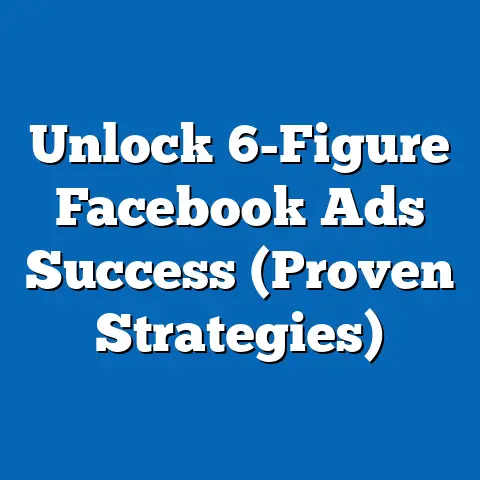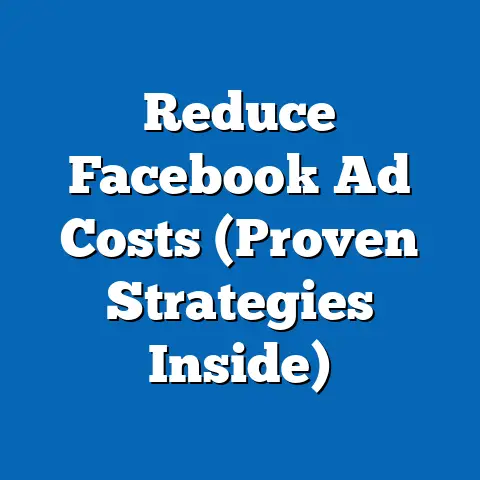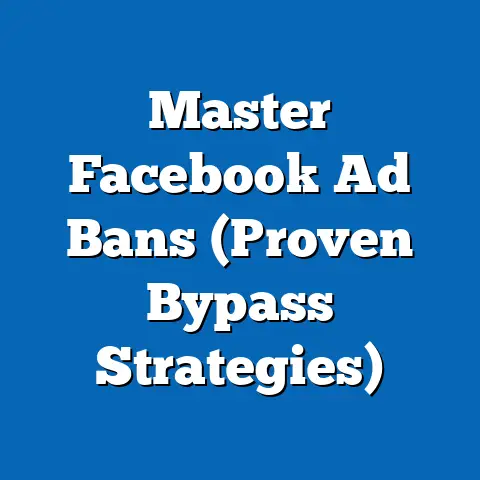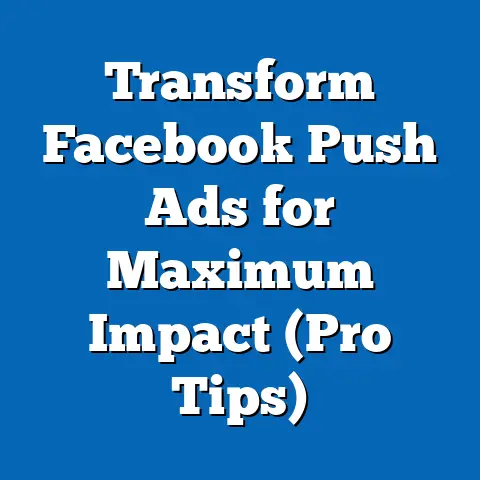Unlock $50 Off Facebook Ads (Proven Strategies for Success)
Facebook advertising has become an indispensable tool in the modern digital marketer’s arsenal. In today’s fast-paced, ever-evolving digital landscape, businesses are constantly seeking innovative ways to reach their target audiences, drive engagement, and boost conversions. Facebook, with its massive user base and sophisticated targeting capabilities, offers a powerful platform to achieve these goals. But let’s face it, advertising costs can quickly add up, making it essential to find strategies that maximize your return on investment (ROI).
I remember when I first started running Facebook ads, I was overwhelmed by the options and the potential costs. I spent countless hours tweaking campaigns, analyzing data, and trying to figure out how to get the most bang for my buck. It was a steep learning curve, but through trial and error, I discovered some incredibly effective strategies that not only helped me lower my ad costs but also significantly improved my campaign performance.
One of the key factors that can significantly impact the effectiveness of your Facebook ads is seasonality. By aligning your ad campaigns with specific upcoming seasons or holidays, such as Christmas, Black Friday, or Back-to-School, you can tap into heightened consumer interest and drive increased engagement and conversions. Think about it – people are already in a buying mood during these times, making them more receptive to relevant offers and promotions.
In this article, I’m going to share my proven strategies for successfully using Facebook ads to unlock discounts, including a $50 off offer, and how to leverage seasonal trends to maximize your ad spend. Whether you’re a seasoned marketer or just starting out, these insights will help you create more effective and cost-efficient Facebook ad campaigns that drive real results. Let’s dive in!
Understanding Facebook Ads and Their Benefits
Facebook ads have evolved significantly from simple banner ads to sophisticated, highly targeted marketing tools. Understanding the different types of ads available and their respective objectives is crucial for crafting effective campaigns.
Here’s a quick rundown of some common Facebook ad types:
- Image Ads: These are the simplest form of Facebook ads, featuring a single image and accompanying text. They’re great for showcasing a product or service visually.
- Video Ads: Video ads are highly engaging and can be used to tell a story, demonstrate a product, or provide valuable information.
- Carousel Ads: Carousel ads allow you to display multiple images or videos in a single ad unit, each with its own headline, description, and link. This is perfect for showcasing a range of products or highlighting different features of a single product.
- Collection Ads: These ads are designed for mobile shoppers and feature a main video or image, followed by a collection of products that can be browsed and purchased directly from the ad.
- Lead Ads: Lead ads make it easy for people to sign up for newsletters, request quotes, or download resources without leaving Facebook.
Each of these ad types can be used to achieve different marketing objectives, such as:
- Brand Awareness: Increase awareness of your brand among your target audience.
- Reach: Show your ad to the maximum number of people within your target audience.
- Traffic: Drive traffic to your website or landing page.
- Engagement: Encourage likes, comments, shares, and other interactions with your ad.
- Lead Generation: Collect leads from potential customers.
- Conversions: Drive sales or other desired actions on your website.
The benefits of using Facebook ads are numerous. One of the most significant advantages is the platform’s unparalleled targeting capabilities. You can target users based on demographics, interests, behaviors, and even custom audiences created from your own customer data. This level of precision allows you to reach the people who are most likely to be interested in your products or services.
Another key benefit is cost-effectiveness. Facebook ads can be surprisingly affordable, especially when compared to traditional advertising methods. You can set your own budget and control how much you spend on each campaign.
Finally, Facebook ads offer measurable results. You can track the performance of your ads in real-time using Facebook Ads Manager, allowing you to see exactly how many people are seeing your ads, clicking on them, and converting into customers. This data-driven approach enables you to optimize your campaigns for maximum ROI.
The potential for seasonal campaigns to drive increased engagement and conversions cannot be overstated. By tailoring your messaging and offers to specific seasons or holidays, you can tap into the excitement and buying intent of your target audience.
Key Takeaway: Facebook ads offer a powerful and cost-effective way to reach your target audience and achieve your marketing objectives. Understanding the different ad types and objectives is essential for crafting effective campaigns.
Tapping into Seasonal Trends
One of the most effective strategies for maximizing your Facebook ad spend is to tap into seasonal trends. By aligning your campaigns with specific holidays, events, or times of year, you can take advantage of heightened consumer interest and drive increased engagement and conversions.
Identifying and analyzing seasonal trends relevant to your industry is the first step. Start by brainstorming all the potential holidays, events, and times of year that could be relevant to your business. For example, if you sell gardening supplies, you’ll want to focus on spring and summer. If you sell winter clothing, you’ll want to focus on the colder months.
Once you have a list of potential seasonal trends, do some research to determine which ones are most likely to be successful. Look at past sales data, website traffic, and social media engagement to see which trends have performed well in the past. You can also use tools like Google Trends to see what people are searching for online.
I’ve found that looking at what competitors have done in the past can also be super helpful. See what campaigns they ran, what messaging they used, and how well they performed. This can give you valuable insights into what works and what doesn’t.
Here are some examples of successful seasonal campaigns on Facebook:
- Christmas: Retailers often run Christmas-themed campaigns featuring festive imagery, holiday discounts, and gift guides.
- Black Friday: Black Friday is one of the biggest shopping days of the year, and many businesses run special promotions and deals on Facebook to drive sales.
- Back-to-School: Retailers targeting students and parents often run back-to-school campaigns featuring discounts on school supplies, clothing, and electronics.
- Valentine’s Day: Businesses selling gifts, flowers, and romantic experiences often run Valentine’s Day campaigns to capitalize on the holiday.
The key to creating a successful seasonal campaign is to adapt your messaging and targeting strategies to align with the specific trend. For example, during Christmas, you might want to use festive imagery, highlight holiday discounts, and target people who are likely to be shopping for gifts.
Creating a seasonal marketing calendar is a great way to plan your Facebook ad campaigns effectively. This calendar should include all the relevant holidays, events, and times of year, as well as the specific campaigns you plan to run for each one.
Here’s what I include in my seasonal marketing calendar:
- Date: The date of the holiday or event.
- Theme: The theme of the campaign.
- Target Audience: The target audience for the campaign.
- Messaging: The messaging you plan to use in your ads.
- Offer: The offer you plan to promote in your ads.
- Budget: The budget you plan to allocate to the campaign.
- Timeline: The timeline for the campaign, including start and end dates.
By planning your campaigns in advance, you can ensure that you’re ready to capitalize on seasonal trends when they arrive.
Key Takeaway: Tapping into seasonal trends is a powerful way to maximize your Facebook ad spend. By identifying relevant trends, adapting your messaging and targeting strategies, and creating a seasonal marketing calendar, you can drive increased engagement and conversions.
Strategies for Unlocking Discounts and Maximizing ROI
Now that you understand the importance of seasonal trends, let’s dive into some practical strategies you can employ to maximize your Facebook ad spend and unlock discounts.
1. Optimize Audience Targeting Using Facebook’s Audience Insights:
Facebook’s Audience Insights tool provides valuable data about your target audience, including their demographics, interests, behaviors, and purchase habits. By using this tool, you can refine your audience targeting and ensure that your ads are being shown to the people who are most likely to be interested in your products or services.
I like to use Audience Insights to:
- Identify new interests and behaviors: Discover new interests and behaviors that are relevant to your target audience.
- Refine existing audiences: Narrow down your existing audiences to focus on the most engaged and responsive users.
- Create lookalike audiences: Create lookalike audiences based on your existing customers or website visitors.
2. Utilize A/B Testing to Refine Ad Creatives and Copy for Better Performance:
A/B testing involves creating multiple versions of your ad creatives and copy and then testing them against each other to see which one performs best. By A/B testing, you can identify the most effective elements of your ads and optimize them for maximum performance.
Here’s what I A/B test regularly:
- Headlines: Test different headlines to see which ones grab attention and drive clicks.
- Images: Test different images to see which ones resonate most with your target audience.
- Call-to-actions: Test different call-to-actions to see which ones drive the most conversions.
- Ad Placement: Test different ad placements (e.g., Facebook News Feed, Instagram Feed, Audience Network) to see which ones deliver the best results.
3. Set Up Retargeting Campaigns to Reach Users Who Have Previously Interacted with the Brand:
Retargeting campaigns allow you to reach users who have previously interacted with your brand, such as website visitors, email subscribers, or social media followers. By retargeting these users, you can remind them about your products or services and encourage them to take action.
I find retargeting incredibly effective because:
- It’s highly targeted: You’re reaching people who have already shown an interest in your brand.
- It’s cost-effective: Retargeting campaigns often have a lower cost per acquisition (CPA) than other types of campaigns.
- It’s effective for driving conversions: Retargeting can be a great way to turn website visitors into customers.
4. Leverage Facebook’s Promotional Tools and Offers to Unlock Discounts:
Facebook offers a variety of promotional tools and offers that you can use to unlock discounts for your customers. These include:
- Facebook Offers: Create special offers that users can claim and redeem in-store or online.
- Discount Codes: Provide discount codes that users can enter at checkout to receive a discount on their purchase.
- Promotional Posts: Create promotional posts that highlight special deals and discounts.
By using these tools, you can incentivize customers to make a purchase and drive increased sales.
Let’s look at a real-world example. A local clothing boutique was struggling to drive sales during a slow season. They implemented a Facebook ad campaign using the strategies outlined above. They optimized their audience targeting using Audience Insights, A/B tested different ad creatives and copy, set up retargeting campaigns to reach website visitors, and offered a 20% discount code to customers who made a purchase through the ad. As a result, they saw a 30% increase in sales during the slow season.
Key Takeaway: By optimizing your audience targeting, A/B testing your ads, setting up retargeting campaigns, and leveraging Facebook’s promotional tools, you can maximize your ad spend and unlock discounts for your customers.
Crafting Compelling Ad Creatives
Your ad creative is what captures the attention of your target audience and encourages them to take action. Therefore, it’s crucial to invest time and effort in designing eye-catching visuals and writing engaging copy.
Here are some tips for designing eye-catching ad visuals:
- Use high-quality images or videos: Make sure your visuals are clear, sharp, and visually appealing.
- Use bright colors: Bright colors can help your ads stand out in the Facebook news feed.
- Use contrasting colors: Use contrasting colors to make your text and visuals easier to read.
- Use relevant images: Make sure your images are relevant to your product or service.
- Use images of people: Images of people can help your ads feel more relatable.
Here are some tips for writing engaging ad copy:
- Write clear and concise headlines: Your headlines should grab attention and clearly communicate the value of your product or service.
- Highlight the benefits: Focus on the benefits of your product or service, rather than just the features.
- Use strong verbs: Use strong verbs to create a sense of urgency and excitement.
- Use social proof: Include social proof, such as customer testimonials or reviews.
- Ask a question: Asking a question can help engage your target audience.
Aligning your ad creatives with seasonal themes is especially important during seasonal campaigns. For example, during the holiday season, you might want to use festive imagery, such as Christmas trees, ornaments, and snowflakes. You might also want to use holiday-themed colors, such as red, green, and gold.
A strong call-to-action (CTA) is essential for driving clicks and conversions. Your CTA should tell people exactly what you want them to do, such as “Shop Now,” “Learn More,” or “Sign Up.” Make sure your CTA is clear, concise, and visually prominent.
Key Takeaway: Crafting compelling ad creatives is essential for capturing the attention of your target audience and driving clicks and conversions. Use high-quality visuals, write engaging copy, align your creatives with seasonal themes, and include a strong call-to-action.
Measuring Success and Adapting Strategies
Tracking and measuring the performance of your Facebook ads is crucial for determining whether your campaigns are successful and for identifying areas for improvement.
You can track the performance of your ads using Facebook Ads Manager, which provides a wealth of data about your campaigns, including:
- Reach: The number of people who saw your ads.
- Impressions: The number of times your ads were displayed.
- Clicks: The number of times people clicked on your ads.
- Click-through rate (CTR): The percentage of people who saw your ads and clicked on them.
- Cost per click (CPC): The average cost you paid for each click on your ads.
- Conversions: The number of people who took a desired action after clicking on your ads, such as making a purchase or signing up for a newsletter.
- Conversion rate: The percentage of people who clicked on your ads and took a desired action.
- Cost per acquisition (CPA): The average cost you paid for each conversion.
Key performance indicators (KPIs) that businesses should focus on include CTR, conversion rate, and CPA. These metrics provide valuable insights into the effectiveness of your ads and can help you identify areas for improvement.
I always encourage analyzing data regularly and adapting your strategies based on performance insights. If you see that your CTR is low, you might want to try A/B testing different headlines or images. If you see that your conversion rate is low, you might want to try improving your landing page or offering a discount.
Key Takeaway: Tracking and measuring the performance of your Facebook ads is crucial for determining whether your campaigns are successful and for identifying areas for improvement. Analyze data regularly and adapt your strategies based on performance insights to continuously improve campaign effectiveness.
Conclusion
In conclusion, Facebook advertising offers a powerful platform for businesses to reach their target audiences, drive engagement, and boost conversions. However, advertising costs can quickly add up, making it essential to find strategies that maximize your ROI.
By leveraging seasonal trends and employing proven strategies, such as optimizing audience targeting, A/B testing your ads, setting up retargeting campaigns, and leveraging Facebook’s promotional tools, you can unlock discounts on Facebook ads and drive increased sales.
I encourage you to take action, experiment with the strategies outlined in this article, and consider how you can implement these tactics in your own Facebook advertising efforts. Remember, the key to success is to continuously test, measure, and adapt your strategies based on performance insights.
The impact of effective Facebook advertising on business growth can be significant, especially by taking advantage of seasonal opportunities. By creating compelling ad creatives, targeting the right audience, and offering valuable promotions, you can drive increased engagement, conversions, and ultimately, revenue.
So, go out there and start unlocking the power of Facebook advertising!
Call to Action:
Subscribe to my blog for more insights on Facebook advertising and digital marketing trends, and share your own experiences or questions in the comments section below. Let’s learn and grow together!





